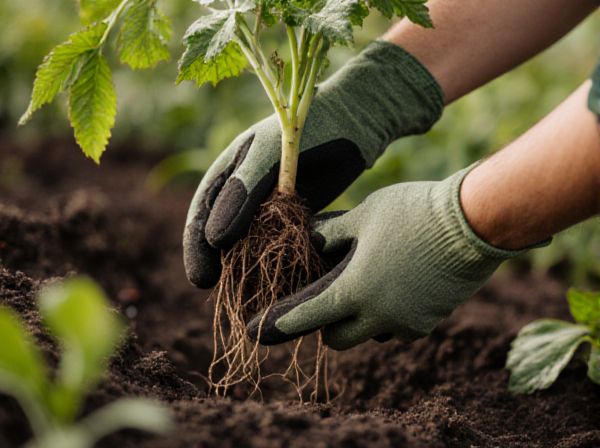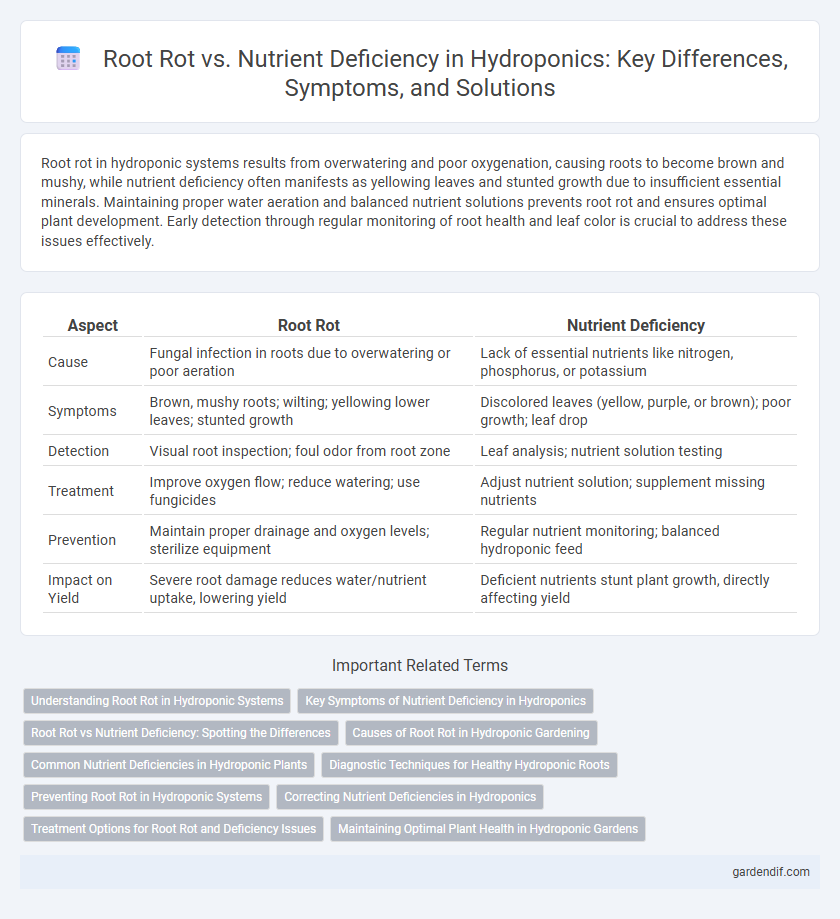
Root Rot vs Nutrient Deficiency Illustration
Root rot in hydroponic systems results from overwatering and poor oxygenation, causing roots to become brown and mushy, while nutrient deficiency often manifests as yellowing leaves and stunted growth due to insufficient essential minerals. Maintaining proper water aeration and balanced nutrient solutions prevents root rot and ensures optimal plant development. Early detection through regular monitoring of root health and leaf color is crucial to address these issues effectively.
Table of Comparison
| Aspect | Root Rot | Nutrient Deficiency |
|---|---|---|
| Cause | Fungal infection in roots due to overwatering or poor aeration | Lack of essential nutrients like nitrogen, phosphorus, or potassium |
| Symptoms | Brown, mushy roots; wilting; yellowing lower leaves; stunted growth | Discolored leaves (yellow, purple, or brown); poor growth; leaf drop |
| Detection | Visual root inspection; foul odor from root zone | Leaf analysis; nutrient solution testing |
| Treatment | Improve oxygen flow; reduce watering; use fungicides | Adjust nutrient solution; supplement missing nutrients |
| Prevention | Maintain proper drainage and oxygen levels; sterilize equipment | Regular nutrient monitoring; balanced hydroponic feed |
| Impact on Yield | Severe root damage reduces water/nutrient uptake, lowering yield | Deficient nutrients stunt plant growth, directly affecting yield |
Understanding Root Rot in Hydroponic Systems
Root rot in hydroponic systems is primarily caused by fungal pathogens such as Pythium, thriving in overly saturated root zones with poor oxygen levels. Differentiating root rot from nutrient deficiency involves observing symptoms like brown, mushy roots and stunted plant growth, whereas nutrient deficiency typically presents as discoloration or deformation in leaves. Properly managing water temperature, oxygenation, and sterilization of equipment helps prevent root rot, ensuring optimal nutrient uptake and plant health in hydroponic environments.
Key Symptoms of Nutrient Deficiency in Hydroponics
Key symptoms of nutrient deficiency in hydroponics include yellowing or chlorosis of leaves, stunted growth, and malformed or discolored foliage. Deficiencies commonly affect essential nutrients such as nitrogen, phosphorus, potassium, calcium, and magnesium, causing specific signs like interveinal chlorosis, necrotic spots, and leaf curling. Early identification of these symptoms enables timely correction of nutrient solutions to maintain optimal plant health and avoid yield loss.
Root Rot vs Nutrient Deficiency: Spotting the Differences
Root rot in hydroponic systems manifests through brown, mushy roots and wilting plants despite adequate water availability, while nutrient deficiency typically causes yellowing or discoloration of leaves due to insufficient essential minerals. Root rot often results from poor oxygenation or overwatering, creating an environment conducive to fungal infections such as Pythium, whereas nutrient deficiencies arise from imbalanced or inadequate nutrient solutions. Spotting the differences involves inspecting root health for signs of decay and monitoring leaf color and growth patterns to accurately diagnose and implement corrective measures in hydroponic setups.
Causes of Root Rot in Hydroponic Gardening
Root rot in hydroponic gardening primarily occurs due to overwatering or poor oxygenation in the nutrient solution, creating an ideal environment for pathogenic fungi such as Pythium species to thrive. Contaminated water, unclean equipment, and inadequate temperature control further exacerbate these conditions, promoting root decay. Nutrient imbalances can weaken plant defenses but are distinct from root rot causes, as deficiency leads to nutrient stress rather than fungal infections.
Common Nutrient Deficiencies in Hydroponic Plants
Common nutrient deficiencies in hydroponic plants include nitrogen, potassium, calcium, magnesium, and iron, each causing distinct symptoms such as yellowing leaves, stunted growth, and poor fruit development. Root rot, caused by pathogens like Pythium spp., differs by manifesting as mushy, discolored roots and overall plant wilting despite adequate nutrient presence. Proper nutrient balance and oxygenation in the hydroponic solution are essential to prevent deficiencies and root rot, ensuring healthy plant growth.
Diagnostic Techniques for Healthy Hydroponic Roots
Root rot in hydroponic systems is identified through symptoms like brown, mushy roots and a foul odor, while nutrient deficiencies manifest as discolored or stunted foliage. Diagnostic techniques include regular root inspections using transparent grow trays and microscopic examination to detect pathogen presence. Additionally, water quality tests measuring pH, electrical conductivity (EC), and dissolved oxygen levels help differentiate between root rot and nutrient imbalance, enhancing early intervention for optimal plant health.
Preventing Root Rot in Hydroponic Systems
Preventing root rot in hydroponic systems requires maintaining optimal oxygen levels and water temperature between 65-75degF to inhibit pathogenic growth like Pythium species. Regular monitoring of pH levels, ideally between 5.5 and 6.5, ensures nutrient availability while preventing stress that makes plants susceptible to root rot. Implementing proper sanitation, including sterilizing equipment and avoiding stagnant water, significantly reduces the risk of root diseases compared to nutrient deficiencies caused by imbalanced feeding schedules.
Correcting Nutrient Deficiencies in Hydroponics
Correcting nutrient deficiencies in hydroponic systems requires precise monitoring of pH levels and electrical conductivity (EC) to ensure optimal nutrient uptake by plant roots. Root rot often mimics nutrient deficiency symptoms but arises from oxygen deprivation or pathogen presence, necessitating improved aeration and sterilization of nutrient solutions. Implementing balanced nutrient formulations tailored to specific crop requirements promotes healthy root development and prevents deficiencies in hydroponic cultivation.
Treatment Options for Root Rot and Deficiency Issues
Effective treatment options for root rot in hydroponic systems include removing affected roots, improving oxygenation through aeration, and applying appropriate fungicides to prevent fungal growth. Nutrient deficiency issues are addressed by adjusting nutrient solution composition, ensuring pH balance between 5.5 and 6.5, and regularly monitoring EC levels to optimize nutrient uptake. Consistent water quality management and maintaining proper system hygiene help prevent both root rot and nutrient deficiencies, promoting healthy plant development.
Maintaining Optimal Plant Health in Hydroponic Gardens
Root rot in hydroponic gardens is caused by overwatering and poor oxygenation, leading to fungal infections that damage plant roots, whereas nutrient deficiency results from imbalanced or insufficient nutrient solutions affecting overall growth and development. Maintaining optimal plant health requires regular monitoring of water pH, dissolved oxygen levels, and nutrient concentration using tools like EC meters to prevent root rot and ensure proper nutrient uptake. Implementing proper aeration, sterilizing equipment, and adjusting nutrient formulas based on plant growth stages promotes a healthy root environment and robust plant development in hydroponic systems.
Root Rot vs Nutrient Deficiency Infographic

 gardendif.com
gardendif.com